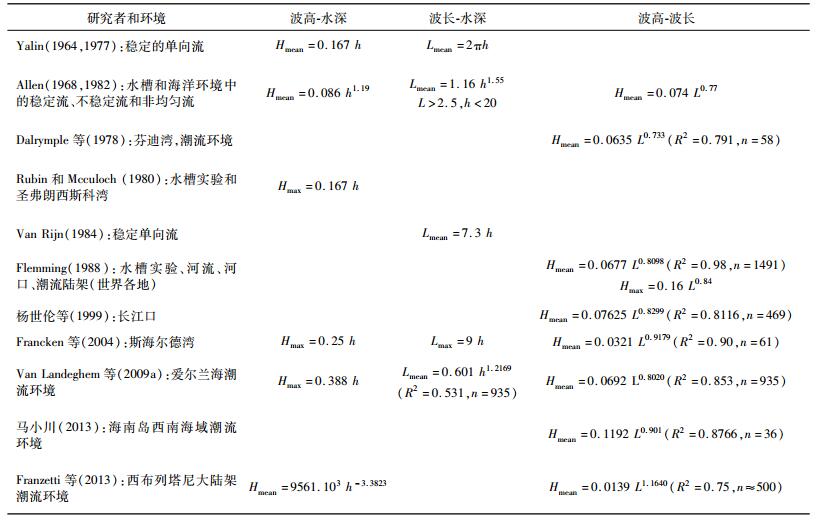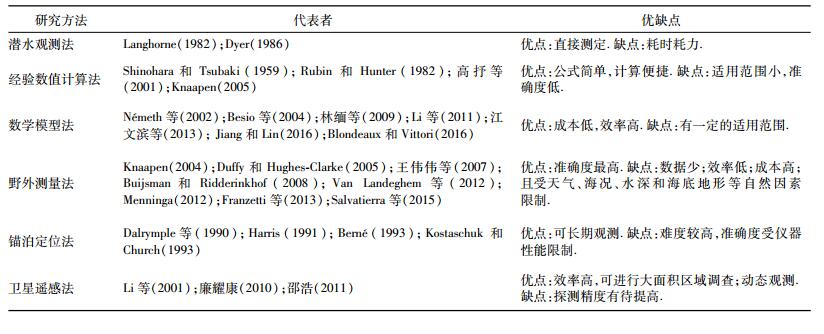海底沙波(submarine sand waves)是一种韵律形的海床地貌形态,沙波的脊线垂直于主水流方向(Allen, 1982; Besio et al., 2006),在河口(Salvatierra et al., 2015)、海湾(Li et al., 2011)、海峡(Idier et al., 2011; Droghei et al., 2016)、海底峡谷(Zhang et al., 2016)、大陆架(Franzetti et al., 2013; Games and Gordon, 2015)和大陆坡(Reeder et al., 2011; King et al., 2014; Bøe et al., 2015)等地貌单元均有存在.国外学者将海底沙波又称为水下沙丘(subaqueous dunes)(Ashley, 1990; Ikehara and Kinoshita, 1994)、海底沙丘(submarine dunes)(Le Bot and Trentesaux, 2004)和沉积物波(sediment waves)(Van Landeghem, 2009a; Reeder et al., 2011; Droghei et al., 2016)等.由于海底沙波大多发育在浅海潮流环境,因此也被称为潮流沙丘(tidal dunes)(Blondeaux and Vittori, 2011, 2016).此外,根据尺度大小,还有波痕(ripples)和大波痕(megaripples)(Amos and King, 1984)等术语.而我国学者通常称其为沙波(夏东兴等,2001)和水下沙丘(杜晓琴和高抒, 2012; Wu et al., 2016),此外还有沙垄(叶银灿等, 2004; 庄振业, 2008)、沙浪(海洋科技名词审定委员会, 2007; 庄振业, 2008)等称谓.
早在19世纪40年代,法国工程师西亚尔就对近海沙波进行了观察研究(Jordan, 1962).20世纪初,英国学者Cornish(1901)研究了潮流环境中的沙波.20世纪50年代后,随着科学技术的进步和仪器装备的发展,国外对沙波的研究如火如荼,取得了一系列重要进展.2000年,在法国北部城市里尔举行了“海洋沙波动态学(MSD)”国际研讨会.2004年,在荷兰东部城市恩斯赫德举行了“海洋与河流沙波动态学(MARID)”国际会议,会议讨论了沙波的起源、演化和活动性.国外研究的热点区域主要有北海(Hulscher and van den Brink, 2001; Games and Gordon, 2015; Blondeaux and Vittori, 2016)、巴伦西亚湾(Albarracín et al., 2014)等.总体而言,目前各国对海底沙波的研究区域还集中在近岸和浅海,对远海和深海沙波的研究很有限度.我国对海底沙波的研究起步较晚,20世纪80年代初至90年代末,我国学者对南海北部(冯文科等, 1982, 1994; 王尚毅和李大鸣, 1994)、东海北部(叶银灿等, 1984)和渤海东部(刘振夏等, 1996)的沙波进行了初步研究.21世纪以来,随着海洋工程装备制造业和海洋经济的发展,我国对近海沙波的研究进入了快车道,主要包括沙波的形态特征(郭兴杰等, 2015; 余威等, 2015; Zheng et al., 2016)、发育与形成条件(庄振业等, 2004; Wu et al., 2016)、稳定性(庄振业等, 2008; 廉耀康, 2010)和运移速率(林缅等, 2009; Li et al., 2011; 邵浩, 2011; Jiang and Lin, 2016)等内容.
由于海底环境的特殊性和复杂性,现代海底沙波的研究高度依赖于技术设备.目前常用的研究方法有经验数值计算法、数学模型法、野外调查法和卫星遥感法.野外调查法主要是通过声学设备对目标区域进行现场调查,然后对数据进行处理和分析,最终得到研究结果,常用的设备包括多波束测深系统、侧扫声呐、浅地层剖面仪、单道地震、声学多普勒流速剖面仪(ADCP)等.此外,卫星遥感技术也应用于海底沙波的研究.
我国近海由北至南,分布着大量的水下沙波地貌,主要位于渤海东部、黄海陆架、东海陆架、长江口、台湾海峡、南海北部陆架-陆坡区、海南岛西部等区域.海底沙波区的砂源可作为建筑、工业(石谦等, 2009)和海岸带管理工程(如沙滩修复补给)使用的材料,是宝贵的海底砂矿资源.但海底沙波的运移可能对海底管线(Németh et al., 2006; Besio et al., 2008; Pu et al., 2013; Games and Gordon, 2015)、海底电缆(Németh, 2002; Besio et al., 2008)、航道港口(Besio et al., 2008; van den Berg et al., 2012)、海上风电机(Games and Gordon, 2015; Blondeaux and Vittori, 2016)、油气平台(Blondeaux and Vittori, 2016)、海底生态系统(Gierlinger et al., 2015)、海底埋藏物(如地雷和化学废料)(Németh et al., 2002)、海底隧道(廉耀康, 2010)、跨海大桥、海洋水下文化遗产、海军活动等海洋开发利用的实践形成危害.此外,在科学领域,对沙波的研究有助于古环境和沉积进程的重建(Dalrymple, 1984; Doré et al., 2016),在古气候变化、古环境演化、海岸线历史变迁等研究方面有着重要意义.因此,研究海底沙波具有重要的理论意义和应用价值.
1 海底沙波的形态和结构特征研究 1.1 海底沙波的外部形态海底沙波的剖面形态是波状的(图 1),形态特征受流速、沉积物粒径、水深等因素控制(Ashley, 1990; 夏东兴等, 2001; Francken et al., 2004; Bartholdy et al., 2005; Barrie et al., 2009).描述沙波形态特征的术语有波高(H)、波长或波脊间距(L)、缓坡投影长(L1)、陡坡投影长(L2)、陡度(H/L)、垂直形态系数(L/H)、对称性指数((L1-L2) /L)、对称形态系数(L1/L2)、缓坡坡度角(α)、陡坡坡度角(β)、缓坡陡峭度(tanα)和陡坡陡峭度(tanβ)等.根据空间形态变化,沙波可分为二维沙波和三维沙波(Ashley, 1990),二维沙波包括直线形、弯曲形、分叉形、格子形等(叶银灿等, 2004; 曹立华等, 2006),三维沙波包括新月形等(图 2);根据大小形态不同,沙波分为小、中、大和巨型(表 1)(Ashley, 1990);还根据剖面形态的对称性,沙波分为对称性沙波和不对称性沙波(刘振夏和夏东兴, 2004).形态特征不仅是海底沙波分类的依据,而且能够指示沙波的沉积环境(Ikehara and Kinoshita, 1994)、移动方向(King et al., 2014)、活动性(Allen, 1980; King et al., 2014)以及流体特性(Kwoll et al., 2016),并可定量地计算沙波的运移速率(Knaapen, 2005).

|
图 1 海底沙波的剖面图 Figure 1 Profile chart of submarine sand waves |

|
图 2 不同类型的沙波空间形态 (a)直线形沙波(Bao et al., 2014); (b)弯曲形沙波(Games and Gordon, 2015); (c)分叉形沙波(Garlan, 2009); (d)新月形沙波(Harris and Baker, 2012). Figure 2 Different spatial form of submarine sand waves (a)Linear sand waves(Bao et al., 2014); (b)Sinuous sand waves(Games and Gordon, 2015); (c) Bifurcating sand waves(Garlan, 2009); (d)Barchans(Harris and Baker, 2012). |
|
|
表 1 水下沙波的分类(Ashley, 1990) Table 1 Classification of subaqueous dunes(Ashley, 1990) |
几何关系是沙波外部形态研究的重要指标,国内外学者曾对此作了大量的研究(Jordan, 1962; Dalrymple, 1978; Flemming, 1988; 杨世伦等, 1999; 高抒, 2009; Van Landeghem et al., 2009a; 马小川, 2013; Salvatierra et al., 2015).由于环境的不同,研究者对沙波几何关系的研究结果也各有差别(表 2),但从表中可以看出,沙波波高(H)和波长(L)的关系式具有幂函数关系,在一定条件下,沙波的波高随着波长的增大而增大,具有明显的正相关关系(图 3).长期以来,因客观条件的限制,研究者对沙波研究都集中在区域范围,不能体现全球的几何特征.20世纪80年代末,Flemming(1988)统计分析了世界各地的1491个沙波,发现平均波高、最大波高与波长的关系式分别为

|
|
|
表 2 沙波的几何关系(修改自Van Landeghem et al., 2009a) Table 2 Geometrical relationships of sand waves from various studies(modified from Van Landeghem et al., 2009a) |
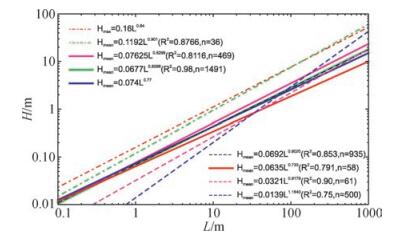
|
图 3 沙波波高与波长的几何关系 Figure 3 Geometric relationships between waveheight and wavelength of submarine sand waves |
由于该关系式统计的沙波数量和分布范围较为广泛,Ashley(1990)曾依据此公式对沙波进行了大小分类.此外,研究者还据此公式与区域进行对比研究,具有广泛的影响,如杜晓琴等(2008)注意到我国台湾浅滩沙波的数据点位于Flemming平均曲线的上方,高抒(2009)认为出现这一现象的原因与推移质输运率有关.值得指出的是,Flemming关系式未能考虑水深大于50 m的潮控大陆架上的巨型沙波(L>1000 m和H>20 m)(Franzetti et al., 2013),其统计数据也缺乏中国浅海陆架的沙波参数(马小川, 2013),因此,从沙波的统计数量、分布范围、所处环境和时空变化等方面分析,Flemming关系式仍然有待改进.
1.2 海底沙波的内部结构沙波的内部结构记录了不同的沉积阶段,因此对沙波内部结构的研究有助于认识沙波的形成和演化机制.沙波内部结构的各级界面代表着特殊的水动力-沉积物进程,研究沙波内部的地层记录能够重建古沉积环境和沉积过程(Le Bot and Trentesaux, 2004).Allen(1980)认为沙波的内部结构和外地貌形态的不对称性程度受到不稳定的和非对称性的潮流流速影响.通过对潮间带沙波的直接观测,Dalrymple(1984)证实上叠的沙波对主沙波的动态演化和内部结构有重要影响.Berné等(1988, 1993)研究了法国大陆架上的浅海沙波,发现沙波主层理由间歇性和季节性的非潮流事件形成的界面构成.Le Bot和Trentesaux(2004)研究发现法国多佛尔海峡与其他大陆架环境上由不同水动力机制形成的沙波,其内部结构的几何特征具有相似性,都具有三种层理,一级层理是水平的,二级层理倾角较小,三级层理倾角较大(图 4),这表明仅对沙波内部结构的层理特征描述并不能确定沙波发育的水动力环境,因此也就不能重建古沉积环境.而沙波内部结构的二级交错层理厚度与特定的水动力-沉积物相互作用进程和沉积物运输量相关,因此能够更好地重建古沉积环境.刘振夏和夏东兴(2004)定性地描述了海底沙波的稳定性,在浅地层剖面图像上,活动性强的沙波在脊顶常有透明层,陡坡则呈反射散乱现象,另外,沙波与其下伏的海床面间界面清楚是沙波不断前行的反映;活动性弱的沙波与此相反,相对稳定.Ferret等(2010)根据声学反射剖面,识别了英吉利海峡东部不同类型的沙波内部结构,沙波的主层理由二级不连续面构成,二级界面的形成周期约为4~18年,时间间隔符合长期的潮流周期,也符合北欧暴风活动年际到十周年的变化周期.并提出了二级不连续面形成的两种假说:二级界面是在弱能期形成的沉积面,亦或在异常风暴期引起了沙波反向运动时形成的侵蚀面.Ma等(2013)等通过一个典型沙波的二级界面,揭示了暴风对沙波形态演化的影响,间歇性的暴风会引起床砂输运量的短期增长,但并不会影响沙波形态的长期演化.
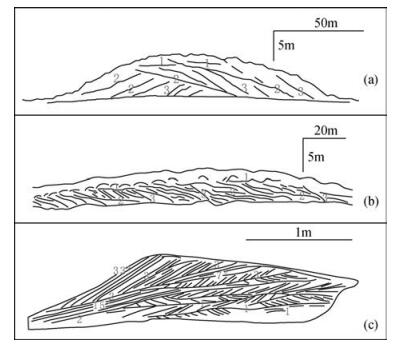
|
图 4 不同大陆架环境中沙波的内部结构特征 (a)多佛尔海峡(Le Bot and Trentesaux, 2004); (b)法国诺曼底近岸(Berné, 1988); (c)芬迪湾(Dalrymple, 1984). Figure 4 Internal structure of sand waves in the different continental shelf environments (a) Dover Strait(Le Bot and Trentesaux, 2004); (b) Off the coast of Normandy in France(Berné, 1988); (c) Bay of Fundy(Dalrymple, 1984). |
影响海底沙波形成和发育的影响因素主要有水动力作用、沉积物供给量、粒径、黏聚力作用、水深、海平面变化和地形环境等.
2.1 水动力作用水动力作用包括水动力大小和类型,由于海水的侵蚀作用和搬运作用以及泥沙的运动和沉积规律都与水动力作用密切相关,故水动力作用是形成海底沉积地貌的主要因素.在水槽实验中,随着流速的增加,沙波的形成要经过不同的发展阶段,不同的学者观点各有差异(钱宁和万兆惠, 1983; 曾允孚和夏文杰, 1986).研究沙波与流体条件要涉及到流体的流态,流态的直接标志为弗劳德数(Fr)的大小,Fr为无量纲数,
庄振业等(2004)通过统计不同沙波研究区的水动力大小,认为20~100 cm/s的底流速是形成陆架沙波的动力条件.总体来看,控制海底沙波形成和发育的水动力作用主要有4个方面:
(1) 潮流作用.大多数海底沙波出现在潮流环境,Huntley等(1993)首次用数值模型研究了在往复潮流作用下沙波的形成,通过线性稳定性分析,Hulscher(1996)认为在潮流作用下平坦砂质海床固有的不稳定性是潮流沙波形成的原因.
(2) 海流作用.Flemming(1978)认为位于非洲大陆边缘东南部的水下沙波的形成受到海流作用的影响;Ikehara和Kinoshita(1994)研究发现大隅海峡的海底沙波的形成和沉积物输运都受到海流的控制.
(3) 波浪作用.海洋中的波浪作用非常活跃,根据波浪在海洋中的位置,波浪分为表面波、内波和边缘波等,表面波作用力可达半波长深的海底,内波是密度稳定层结的海水内部产生的波动,其波高甚至比表面波还大.Karl等(1986)指出内波流可能是形成海底峡谷沙波的水动力因素.Marin等(2005)在实验室研究了浅水孤立波形成床砂形态的机制,由稳定谐波生成的孤立波起初作用在平坦的砂床,接着在床面快速形成了波痕,最终波痕的波长约达到床砂中值粒径的1000倍.南海东北部上大陆坡的沙波分布在水深160~600 m的海底,Reeder等(2011)发现内孤立波形成了200 m厚的海洋雾状层,并进一步认为海底沙波是由内孤立波形成的.Droghei等(2016)通过数值模拟表明内孤立波流速能够移动海底沉积物,证实意大利墨西拿海峡的沙波由内孤立波作用形成.
(4) 综合作用.还有研究者认为,海底沙波是在浪流联合作用下形成的(Gadd et al., 1978; Pattiaratchi and Collins., 1985).
由此可见,多种水动力作用都能够形成海底沙波,但研究者对形成沙波的水动力机制还未形成共识.尤其是在深海,因限于对水动力和沉积物搬运过程的观测,科学家对影响沙波形成的水动力机制仍不明确.
2.2 沉积物供给量、粒径和黏聚力作用充足的沉积物供给量为沙波的形成和发育提供了物质基础.沉积物供给量的丰裹会形成不同形状的沙波,沉积物供给量充盈会发育成直线形沙波,供给量不足则会发育新月形沙波,供给量中等会发育侵蚀带、沙脊、新月形沙波、直线形沙波和沙斑等海底沉积砂体(夏东兴等, 2001).另外,粒径大小也会对沙波的形成和发育产生重要影响.在水深足够深和流速足够高的时候,沉积物粒径越大,沙波发育的尺度也会越大(Flemming, 2000)(图 5).长江口沙波区的床沙中值粒径基本为细砂,沙波的大小与床沙中值粒径呈正相关(郭兴杰等, 2015).
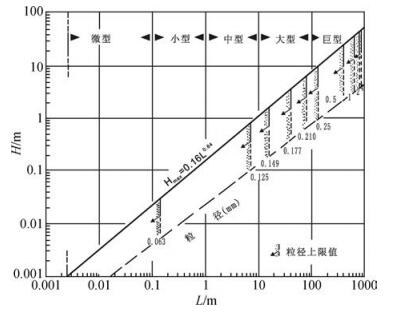
|
图 5 沙波大小与沉积物粒径的函数关系(Flemming, 2000) Figure 5 Waveheight versus wavelength as a function of grain size(Flemming, 2000) |
以往的研究认为影响海底床砂地貌形成和发育的因素主要有水动力作用、沉积物供给量、粒径等,然而最近研究表明黏聚力作用也对海底沙波的形成和发育有深远的影响.黏聚力作用包括机械黏聚力作用、生物黏聚力作用和化学黏聚力作用等.海底床砂地貌的形成和发育与沉积物输运率密切相关,经典的沉积物输运率研究基于无黏性的净砂,但很多水下环境由无黏性的砂质沉积物、机械黏性的泥质沉积物和生物黏性的海底有机体混合组成(Malarkey et al., 2015; Parsons et al., 2016).基于控制变量的室内实验,Baas等(2013)和Schindler等(2015)、Malarkey等(2015)分别研究了机械黏聚力、生物黏聚力对水下沙丘发育的影响,这些研究不仅表明生物黏聚力与机械黏聚力都会抑制沙波的生长,而且也阐明两者之间的区别.Parsons等(2016)首次研究了机械和生物黏聚力对沙丘地貌均衡状态的影响,结果表明生物黏聚力作用比机械黏聚力作用更为有效地减少沙波的大小和陡度,而生物和机械黏聚力共同作用会对沙波的形成和发育造成更强的抑制作用.
2.3 水深环境从数米到数千米深的海底,都有沙波发育.Flemming(2000)认为,在浅水,沙波的波高(或波长)与水深密切相关,在深水反之,沙波的增长不受水深影响.庄振业等(2004)认为,陆架浅水区(<18 m)因受破波削顶作用使沙丘尺度与水深呈微弱负相关关系, 深水区(>18 m)水深对沙丘发育的影响甚微.一般而言,在同一区域的海底,沙波的最大波高不会超过水深的0.4倍(表 2).而在不同区域的海底,沙波的大小不会仅随着水深的增大而增大.例如,爱尔兰海的沙波出现在水深179 m范围以内,在水深91.5m的海底,沙波的波高和波长分别达到了35.5 m和435 m(Van Landeghem et al., 2009a);挪威北部巴伦支海大陆坡上的沙波出现在475~800 m的水深范围内,平均波长64 m,最大波长205 m,平均波高0.6 m,最大波高5~6 m(Bøe et al., 2015).因此,水深是海底沙波发育的前提条件,但不是控制沙波增长的主要因素,Franzetti等(2013)在研究中也证实了这一观点.
2.4 海平面变化末次盛冰期(LGM)时期,全球海平面降至最低,低于现今100 m以上,末次盛冰期结束至约7 ka BP,海平面快速上升,约7 ka BP以来,海平面基本与现今相同.首先,海平面升降导致了海进和海退层序的形成,部分古老沙波可能被后期沉积物所覆盖,形成埋藏沙波.其次,海平面变化会改变潮流和波浪的强度,进而影响床沙载荷的输运和沉积规律,使露出海床面的古沙波演化成为残留沙波.Albarracín等(2014)构建了沙波形成的相对海平面曲线(图 6),认为巴伦西亚湾(地中海西部)的残留沙波形成于新仙女木期(12~10 ka BP),当时区域海平面低于现今30~50 m.爱尔兰海的巨型沙波,波高达到35.5 m(Van Landeghem et al., 2009a),沉积物由粗砂和细砾组成,现今的水动力条件不足以使这些沙波显著地增长和移动,Van Landeghem等(2009b)建立了一个二维古潮流模型,模拟表明潮流引起的剪应力从7~10 ka BP增长,认为这些巨型沙波可能形成于这一时期;巴伦支海的残留沙波,形成于13~11 ka BP(Bøe et al., 2015).因此,海平面变化对沙波的形成和活动性有重要的影响.
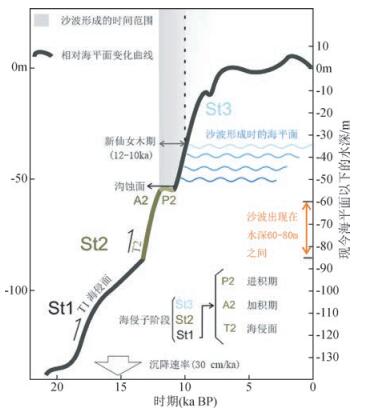
|
图 6 巴伦西亚湾相对海平面变化曲线(Albarracín et al., 2014) Figure 6 Regional relative sea level curve in the Gulf of Valencia(Albarracín et al., 2014) |
水动力和沉积物输运会改变海底地形,反过来海底地形会影响水动力作用的强弱和沉积物的输运动态,形成一种反馈机制.叶银灿等(叶银灿等, 2004; 叶银灿, 2012)研究发现,我国东海陆架大部分是冰期低海面时的古长江下游平原,地形平坦,平均坡度仅17″~20″,适合于沙波的发育.庄振业等(2004)认为平缓广阔的砂质海底是发育陆架沙波的地形条件, 而坡度过缓和过陡均不利于沙波的发育.然而,坡度较陡的大陆坡等地貌单元也发育海底沙波(Reeder et al., 2011; King et al., 2014; Bøe et al., 2015),因此,海底地形坡度对于沙波形成和发育的影响需要进一步的量化研究.除了地形坡度以外,海底粗糙度也会影响沙波的形成和运移(Idier et al., 2004; 叶银灿, 2012).
在自然界中,海底沙波的形成和发育条件通常要比理论研究模式复杂很多,主要表现在沙波形成条件的多样性.从狭义上讲,多样性表现在不同的环境条件下均有沙波发育,如潮流环境、海流环境等;从广义上说,多样性表现在水动力作用、沉积物供给量、粒径、黏聚力作用、水深、海平面变化和地形等因素相互组合,构成的多种综合因素也能够影响沙波的形成和发育.此外,技术手段的限制也会影响对沙波形成的研究,尤其是在深海等复杂环境.
3 海底沙波的运移研究近几十年来,海洋工程发展迅速,而海底沙波的存在会对海洋工程形成潜在的威胁,如移动的沙波可能造成管线悬空折断、航道淤塞碍航、油气平台结构失稳等事故.因此,海底沙波的运移是工程师和科学家研究的焦点,包括对运移方向和大小的研究.运移率越大,海底沙波的稳定性则越差,反之,稳定性则越好.
3.1 海底沙波的运移方向沙波的不对称性形态可以指示其运移方向,一般认为沙波的运移方向是从沙波的缓坡指向陡坡,但有研究表明,沙波也可以从陡坡向缓坡运移(Van Landeghem et al., 2012),这意味着仅靠沙波的不对称性判断沙波运移方向并不十分准确.Németh等(2002)通过建立二维模型(2DV), 然后利用线性稳定性分析讨论了沙波的形成和运移,认为沙波的运移方向和余流方向相同,如英吉利海峡东部海底沙波的运移方向与余流方向一致(Ferret et al., 2010).然而,通过模型模拟和实测数据分析,一些学者发现沙波运移方向也会与余流方向相反(Besio et al., 2004; 江文滨等, 2013; Jiang and Lin, 2016).显然,仅凭余流方向来判断沙波的运移方向也并不可靠,还应考虑其他的相关因素.
3.2 海底沙波的运移大小海底沙波的运移大小一般是指沙波的水平运移速率大小.研究海洋沙波的水平运移速率有多种方法,不同的方法各有优劣(表 3),目前主要的研究方法有经验数值计算法、野外测量法、数学模型法、卫星遥感法.
|
|
表 3 研究海底沙波水平运移速率的不同方法的优缺点 Table 3 The advantage and disadvantage of different methods for the horizontal migration rates of submarine sand waves |
经验数值计算法一般是通过实验、模型或野外调查得来的,具有公式简单、计算便捷的特征,故应用较为广泛,常用的数学表达式有3个(表 4).20世纪50年代末,日本学者Shinohara和Tsubaki(1959)提出了计算沙波运移速率的公式,许多学者曾根据此式分别计算了我国南海北部和海南东方岸外海底沙波的运移速率(冯文科等, 1994; 王尚毅和李大鸣, 1994; 夏东兴等, 2001; 林缅等, 2009).夏东兴等(2001)计算得到,海南东方岸外20~40 m水深区域的沙波运移速率0.57~1.99 m/a,远小于本区实测的沙波运移速率,可能是Shinohara-Tsubaki公式未考虑风暴浪流及沙波波高的影响(李泽文等, 2010).20世纪80年代,美国学者Rubin和Hunter(1982)假设沙波纵剖面为近似斜面,用底沙输运率和沙波形态等参数计算沙波运移速率,高抒等(2001)对此式进行了简化,王伟伟(2007)使用该表达式计算得到的海南西南海底沙波运移速率与多波束重复测量结果极为吻合.Knaapen(2005)根据北海和英吉利海峡实测的多波束数据,总结出沙波运移速率与沙波形状的经验公式,林缅等(2009)和廉耀康(2010)依据此关系式分别计算了海南西南海域和台湾海峡西北部的沙波运移速率,计算结果均与实际观测结果相差较大.总体而言,经验数值计算法受到各参数的影响,适用范围小,且准确度低,仅可用于粗略估算沙波的运移速率.
|
|
表 4 计算沙波运移速率的不同数学表达式 Table 4 Different mathematical expressions for calculating the migration speed of sand waves |
野外测量法是现代海底沙波研究的基础,研究沙波运移的方法主要包括多波束测量法和ADCP测量法等,其中以多波束测量法为主流,两种方法都以获取的高精度数字地形模型(DTM)数据为基础,数据分析方法也可分为两种方式,一种是剖面分析法,另一种是空间互相关技术法.剖面分析法进一步分为剖面对比法和线性回归法.剖面分析法是利用从DTM数据提取出的波脊线和波谷线特征信息,然后辨识出沙波的运移方向,再构建一条或数条沙波剖面线,最后通过对比剖面图上的波脊线(或波谷线)的位置来分析沙波的运移.Knaapen(2004)、Van Dijk和Kleinhans(2005)、王伟伟等(2007)、Van Landeghem等(2012)、Salvatierra等(2015)通过多波束测深系统获取的DTM数据,应用这一方法计算了沙波的运移速率.线性回归应用于确定沙波脊线和谷线的位置,回归系数表示沙波脊线和谷线的平均运移速率,Menninga(2012)通过比较线性回归法和剖面对比法,认为线性回归法计算得到的结果更为可靠,并用线性回归法计算了荷兰近海沙波的运移速率.周洁琼等(2015)等基于复合数字水深模型,提出了一种适用于海底沙波脊线与谷线自动识别的方法,可有效地提升剖面对比法的效率和准确度.应用剖面分析法计算得到的结果只能代表沙波脊线一处或几处的运移速率(决定于剖面的数量),并不能代表整个沙波脊线的运移速率.空间互相关技术法是一种依据沙波形态在空间分布的相关程度,利用多时相DTM数据定量分析沙波运移速率的方式.Duffy和Hughes-Clarke(2005)最早使用空间互相关技术计算了海底沙波的运移速率,Buijsman和Ridderinkhof(2008)基于ADCP获取的高分辨率DTM数据,利用改进后的空间互相关方法,成功地确定了潮汐通道中的沙波运移速率的季节变化.相比剖面分析法,上述4位学者运用的空间互相关技术法基于二维分析,可计算沙波整条脊线处的水平运移量,但不能确定沙波的垂直变化.最近,Franzetti等(2013)使用三维分析的空间互相关技术,不仅计算了沙波的水平运移速率,还分析了沙波的垂直变化.迄今为止,野外测量法是定量测定沙波运移最精确的方式.
3.2.3 数学模型法数学模型不仅能解释沙波的形成,而且能预测沙波的运移,是一种经济、高效的研究方式.Németh等(2002)基于线性稳定性分析,利用二维垂向模型(2DV), 讨论了沙波的形成,并首次用模型研究了沙波的运移.Besio等(2004)考虑了分潮方向、大小和位相等参数,模拟了沙波的运移.线性稳定性分析模型的有效性局限于小振幅沙波(Németh et al., 2006),他们的计算结果是半定量的,且忽略了一些海洋环境参数的影响.Blondeaux和Vittori(2016)利用改进后的线性稳定性分析模型模拟了海底沙波的形态变化和运移速率,尽管考虑了多种环境参数,但沙波的运移速率却高于实际观测值.林缅等(2009)、Li等(2011)建立了准三维力学模型(Q3D),模拟了O1、K1、M2分潮作用下南海小尺度沙波的运移,综合考虑了粒径、潮流、风海流和沙波形状等因素,但该模型却无法准确模拟海底地形起伏较明显区域的沙波.江文滨等(2013),Jiang和Lin(2016)构建了高分辨率三维海洋环境数值,模拟了我国南海北部小尺度沙波运移,该模型由超高分辨率三维海洋环境数值模块和泥沙运移模块组成,综合考虑了地形、潮汐、温盐和风应力等因素对海底流场和沙波运移的影响,可预测沙波运移趋势,与实测结果相比,该模型优于2DV和Q3D模型.值得指出的是,该模型在模拟沙波运移过程时,仅考虑了主要的分潮;另外,该模型假定沙波的形状未发生改变,但在实际情况中,沙波在运移时形态或多或少会发生改变,在一些极端条件下,沙波形态甚至会发生巨大改变,因此,该模型还有待进一步改进.目前许多研究者针对不同的研究区提出了各自不同的模型,尚无能够普遍适用的数学模型.
3.2.4 卫星遥感法1978年,美国成功发射了世界上第一颗海洋卫星SEASAT,掀开了遥感卫星专门研究海洋的序幕.21世纪初,Li等(2001)首次使用多时相星载合成孔径雷达图像研究了台湾浅滩沙波的运移.廉耀康(2010)、邵浩(2011)通过对比LANDSAT 5 TM遥感图像,估算了台湾浅滩沙波的运移速率.He等(2014)利用卫星影像和多波束数据的特征信息,提出了一种计算沙波区水深的方法,该法可以高效获取沙波区的水深数据,但随着多波束测量条带间距的增加,插值精度会降低.He等(2015)通过分析“HJ-1A/B”CCD相机获取的沙波影像机制和几何特征,解释了沙波的亮度反转机制,结果表明当在利用太阳耀光影像研究台湾浅滩沙波的空间特性和运移时,应避免亮度反转位置;当使用太阳耀光影像进行沙波水深反演时,要利用沙波的影像特性,选择位于亮度反转位置和最亮位置之间的影像区位.随着卫星精度和空间分辨率的进一步提高,卫星遥感技术在浅海沙波研究领域具有良好的应用前景.
4 研究展望在过去的100多年,尽管海底沙波的研究取得了重要的进展,但对沙波研究的深度和广度及对其形成发育和演化运移机理研究还没有形成系统,至今仍然是海洋学家研究的热点与难点.原因在于沙波研究具有实践性、综合性、复杂性、全球性等特点.
(1) 实践性:沙波的研究需要进行现场调查,对技术手段依赖很强.
(2) 综合性:沙波的研究涉及众多学科体系,包括海洋地质学、海洋沉积学、海洋测量学、物理海洋学、流体力学、海洋地球物理学和生物学等.
(3) 复杂性:海底沙波的形成和演化过程十分复杂,首先,影响海底沙波形成和演化的因素多样;其次,沙波的演化时间尺度大,从数月到数万年;此外,海洋环境本身是一个非常复杂的环境,这也加剧了对沙波研究的复杂程度,尤其是对分布在数百米以上深度的海底沙波的研究,由于客观条件所限,面临着巨大的挑战.
(4) 全球性:沙波广泛分布于世界各地,从近岸到远海,从浅海到深海,都有沙波发育,分布空间尺度大.为此,未来沙波研究亟待从以下几方面发展和推进.
4.1 多学科理论不同的学科从不同的角度对海底沙波进行了研究,但学科本身具有局限性和片面性,应充分利用多学科理论,采用系统科学的思想才能对沙波进行更为深入和全面的剖析与认知.
4.2 多技术手段单一手段无法满足海底沙波的研究,特别是对沙波运移的研究.海底沙波的研究手段是由众多方法如野外观测法、数学模型法、卫星遥感法和深水试验池法等构成的体系.随着海洋仪器观测精度、空间分辨率和观测周期的提高,野外调查法直接为沙波研究提供实测数据,而数据是现代海底沙波统计分析和研究应用的基础.数学模型法因其高效经济和能够进行仿真研究的特点,在沙波研究领域得到广泛运用且前景良好,但目前其适用范围还很局限,而根据野外调查获取的数据,可以有效校正模型,进一步提高数学模型模拟的准确度和适用性.近年来,卫星海洋遥感技术的发展为沙波研究提供了更多的手段.而遥感(RS)技术和地理信息系统(GIS)的结合能够促进沙波运移的数字化研究,从而实现海底沙波的动态监测.如今,先进的深水试验池可以模拟风、浪、流等多种海洋环境条件,这种先进的深水试验池可应用于海底沙波的案例化、项目化和仿真研究,这对于推动海底沙波的实验室研究有着重要作用.
4.3 定量化研究定量化研究能够提高沙波研究的科学性和精确性,是沙波研究发展的重要方向和主要趋势.定量化研究的范畴包括沙波运移速率和方向、演化、稳定性量级、发育条件、分类等.在海洋工程建设和维护时,定量化研究尤为重要,主要包括两方面,一是要确定海底沙波的运移速率和方向,二是要确定沙波的空间大小.目前,对于海底沙波的运移研究还处于定性和半定量阶段.而对于沙波的大小分类原则,也未形成共识.因此,沙波的定量化研究水平仍需进一步完善.
4.4 国际化合作现阶段对海底沙波的研究主要局限于区域研究,对分布在世界各地的沙波缺乏统一的认识和研究.沙波的数据统计分析大都依靠文献,大型的国际合作项目和交流仍然缺乏.因此,加强国际合作和数据共享,对于拓宽沙波研究的时空尺度非常必要.
致谢 感谢审稿专家对文章提出的宝贵意见,也感谢编辑部的鼎力支持.| [] | Albarracín S, Alcántara-Carrió J, Montoya-Montes I, et al. 2014. Relict sand waves in the continental shelf of the Gulf of Valencia (Western Mediterranean)[J]. Journal of Sea Research, 93: 33–46. DOI:10.1016/j.seares.2013.12.014 |
| [] | Allen J R L. 1980. Sand waves: A model of origin and internal structure[J]. Sedimentary Geology, 26(4): 281–328. DOI:10.1016/0037-0738(80)90022-6 |
| [] | Allen J R L. 1982. Developments in Sedimentology[M]. Amsterdam: Elsevier: 953. |
| [] | Amos C L, King E L. 1984. Bedforms of the Canadian eastern seaboard: A comparison with global occurrences[J]. Marine Geology, 57(1-4): 167–208. DOI:10.1016/0025-3227(84)90199-3 |
| [] | Ashley G M. 1990. Classification of large-scale subaqueous bedforms: A new look at an old problem-SEPM bedforms and bedding structures[J]. Journal of Sedimentary Petrology, 60(1): 160–172. DOI:10.1306/212F9138-2B24-11D7-8648000102C1865D |
| [] | Baas J H, Davies A G, Malarkey J. 2013. Bedform development in mixed sand-mud: The contrasting role of cohesive forces in flow and bed[J]. Geomorphology, 182: 19–32. DOI:10.1016/j.geomorph.2012.10.025 |
| [] | Bao J J, Cai F, Ren J Y, et al. 2014. Morphological characteristics of sand waves in the middle Taiwan Shoal based on multi-beam data analysis[J]. Acta Geologica Sinica, 88(5): 1499–1512. DOI:10.1111/1755-6724.12314 |
| [] | Barrie J V, Conway K W, Picard K, et al. 2009. Large-scale sedimentary bedforms and sediment dynamics on a glaciated tectonic continental shelf: Examples from the Pacific margin of Canada[J]. Continental Shelf Research, 29(5-6): 796–806. DOI:10.1016/j.csr.2008.12.007 |
| [] | Bartholdy J, Flemming B W, Bartholomä A, et al. 2005. Flow and grain size control of depth-independent simple subaqueous dunes[J]. Journal of Geophysical Research, 110(F4): F04S16. DOI:10.1029/2004JF000183 |
| [] | Berné S, Auffret J P, Walker P. 1988. Internal structure of subtidal sandwaves revealed by high-resolution seismic reflection[J]. Sedimentology, 35(1): 5–20. DOI:10.1111/j.1365-3091.1988.tb00902.x |
| [] | Berné S, Castaing P, Le Drezen E, et al. 1993. Morphology, internal structure, and reversal of asymmetry of large subtidal dunes in the entrance to Gironde Estuary (France)[J]. Journal of Sedimentary Research, 63(5): 780–793. DOI:10.1306/D4267C03-2B26-11D7-8648000102C1865D |
| [] | Besio G, Blondeaux P, Brocchini M, et al. 2004. On the modeling of sand wave migration[J]. Journal of Geophysical Research, 109(C4): C04018. DOI:10.1029/2002JC001622 |
| [] | Besio G, Blondeaux P, Brocchini M, et al. 2008. The morphodynamics of tidal sand waves: A model overview[J]. Coastal Engineering, 55(7-8): 657–670. DOI:10.1016/j.coastaleng.2007.11.004 |
| [] | Besio G, Blondeaux P, Vittori G. 2006. On the formation of sand waves and sand banks[J]. Journal of Fluid Mechanics, 557: 1–27. DOI:10.1017/S0022112006009256 |
| [] | Blondeaux P, Vittori G. 2011. A parameterization of the wavelength of tidal dunes[J]. Earth Surface Processes and Landforms, 36(9): 1152–1161. DOI:10.1002/esp.2137 |
| [] | Blondeaux P, Vittori G. 2016. A model to predict the migration of sand waves in shallow tidal seas[J]. Continental Shelf Research, 112: 31–45. DOI:10.1016/j.csr.2015.11.011 |
| [] | Bøe R, Skarðhamar J, Rise L, et al. 2015. Sandwaves and sand transport on the Barents Sea continental slope offshore northern Norway[J]. Marine and Petroleum Geology, 60: 34–53. DOI:10.1016/j.marpetgeo.2014.10.011 |
| [] | Buijsman M C, Ridderinkhof H. 2008. Long-term evolution of sand waves in the Marsdiep inlet. I: High-resolution observations[J]. Continental Shelf Research, 28(9): 1190–1201. DOI:10.1016/j.csr.2007.10.011 |
| [] | Cao L H, Xu J S, Li G X, et al. 2006. High-resolution morphological characteristics of sand waves off the west Hainan island[J]. Marine Geology & Quaternary Geology, 26(4): 15–22. DOI:10.16562/j.cnki.0256-1492.2006.04.003 |
| [] | Cornish V. 1901. On sand-waves in tidal currents[J]. The Geographical Journal, 18(2): 170–200. DOI:10.2307/1775345 |
| [] | Dalrymple R W. 1984. Morphology and internal structure of sandwaves in the Bay of Fundy[J]. Sedimentology, 31(3): 365–382. DOI:10.1111/j.1365-3091.1984.tb00865.x |
| [] | Dalrymple R W, Knight R J, Lambiase J J. 1978. Bedforms and their hydraulic stability relationships in a tidal environment, Bay of Fundy, Canada[J]. Nature, 275(5676): 100–104. DOI:10.1038/275100a0 |
| [] | Dalrymple R W, Knight R, Zaitlin B A, et al. 1990. Dynamics and facies model of a macrotidalsand-bar complex, Cobequid Bay-Salmon River Estuary (Bay of Fundy)[J]. Sedimentology, 37(4): 577–612. DOI:10.1111/j.1365-3091.1990.tb00624.x |
| [] | Doré A, Bonneton P, Marieu V, et al. 2016. Numerical modeling of subaqueous sand dune morphodynamics[J]. Journal of Geophysical Research, 121(3): 565–587. DOI:10.1002/2015JF003689 |
| [] | Droghei R, Falcini F, Casalbore D, et al. 2016. The role of Internal Solitary Waves on deep-water sedimentary processes: The case of up-slope migrating sediment waves off the Messina Strait[J]. Scientific Reports, 6: 36376. DOI:10.1038/srep36376 |
| [] | Du X Q, Gao S. 2012. An evolution of subaqueous dune morphology: Numerical experiments[J]. Acta Oceanologica Sinica, 34(4): 121–134. |
| [] | Du X Q, Li Y, Gao S. 2008. Characteristics of the large-scale sandwaves, tidal flow structure and bedload transport over the Taiwan Bank in southern China[J]. Acta Oceanologica Sinica, 30(5): 124–136. |
| [] | Duffy G P, Hughes-Clarke J E. 2005. Application of spatial cross correlation to detection of migration of submarine sand dunes[J]. Journal of Geophysical Research, 110(F4): F04S12. DOI:10.1029/2004JF000192 |
| [] | Dyer K R. 1986. Coastal and Estuarine Sediment Dynamics[M]. Chichester: Wiley-Interscience Publication: 272-283. |
| [] | Examination and Approval Committee of Terms in Marine Science and Technology. 2007. Chinese Terms in Marine Science and Technology[M]. 2nd ed. Beijing: Science Press: 60. |
| [] | Feng W K, Bao C W, Chen J R, et al. 1982. Preliminary study on submarine relief of the northern South China Sea[J]. Acta Oceanologica Sinica, 4(4): 462–472. |
| [] | Feng W K, Li W F, Shi Y H. 1994. Study on seafloor sandwaves dynamics in the northern South China Sea[J]. Acta Oceanologica Sinica, 16(6): 92–99. |
| [] | Ferret Y, Le Bot S, Tessier B, et al. 2010. Migration and internal architecture of marine dunes in the eastern English Channel over 14 and 56 year intervals: The influence of tides and decennial storms[J]. Earth Surface Processes and Landforms, 35(12): 1480–1493. DOI:10.1002/esp.2051 |
| [] | Flemming B W. 1978. Underwater sand dunes along the southeast African continental margin—observations and implications[J]. Marine Geology, 26(3-4): 177–198. DOI:10.1016/0025-3227(78)90059-2 |
| [] | Flemming B W. 1988. Zur klassifikation subaquatischer, stromungstransversaler transportkorper[J]. Bochunmer Geologische und Geotechnische Arbeitin, 29: 44–47. |
| [] | Flemming B W. 2000. The role of grain size, water depth and flow velocity as scaling factors controlling the size of subaqueous dunes[M].//Trentesaux A, Garlan T eds. Marine Sandwave Dynamics. Lille, France: University of Lille, 55-60. |
| [] | Francken F, Wartel S, Parker R, et al. 2004. Factors influencing subaqueous dunes in the Scheldt Estuary[J]. Geo-Marine Letters, 24(1): 14–21. DOI:10.1007/s00367-003-0154-x |
| [] | Franzetti M, Le Roy P, Delacourt C, et al. 2013. Giant dune morphologies and dynamics in a deep continental shelf environment: Example of the banc du four (Western Brittany, France)[J]. Marine Geology, 346: 17–30. DOI:10.1016/j.margeo.2013.07.014 |
| [] | Gadd P E, Lavell J W, Swift D J P. 1978. Estimates of sand transport on the New York shelf using near-bottom current meter observations[J]. Journal of Sedimentary Research, 48(1): 239–252. DOI:10.1306/212F7441-2B24-11D7-8648000102C1865D |
| [] | Games K P, Gordon D I. 2015. Study of sand wave migration over five years as observed in two windfarm development areas, and the implications for building on moving substrates in the North Sea[J]. Earth and Environmental Science Transactions of the Royal Society of Edinburgh, 105(4): 241–249. DOI:10.1017/S1755691015000110 |
| [] | Gao S. 2009. Morphological and migration characteristics of large-scaled submarine, coastal and desert sand dunes[J]. Earth Science Frontiers, 16(6): 13–22. |
| [] | Gao S, Fang G H, Yu K J, et al. 2001. Methodology for evaluating the stability of sandy seabed controlled by sediment movement, with an example of application[J]. Studia Marina Sinica(43): 25–37. |
| [] | Garlan T. 2009. Gis and mapping of moving marine sand dunes[C].//Proceedings of the 24th International Cartographic Conference. Chile: The Military Geographic Institute. |
| [] | Gierlinger T, Brodtkorb A R, Stumpf A, et al. 2015. Visualization of marine sand dune displacements utilizing modern GPU techniques[C].//Christophe S, Cötekin A eds. The International Archives of the Photogrammetry, Remote Sensing and Spatial Information Sciences. La Grande Motte, France: The International Society of Photogrammetry and Remote Sensing, 503-508. |
| [] | Guo X J, Cheng H Q, Mo R Y, et al. 2015. Statistical characteristics and transport law of sand waves in the Yangtze Estuary[J]. Acta Oceanologica Sinica, 37(5): 148–158. DOI:10.3969/j.issn.0253-4193.2015.05.014 |
| [] | Harris P T. 1991. Reversal of subtidal dune asymmetries caused by seasonally reversing wind-driven currents in Torres Strait, northeastern Australia[J]. Continental Shelf Research, 11(7): 655–662. DOI:10.1016/0278-4343(91)90018-2 |
| [] | Harris P T, Baker E K. 2012. Seafloor Geomorphology as Benthic Habitat: GeoHAB Atlas of Seafloor Geomorphic Features and Benthic Habitats[M]. Amsterdam: Elsevier: 270. |
| [] | He X K, Chen N H, Zhang H G, et al. 2014. Reconstruction of sand wave bathymetry using both satellite imagery and multi-beam bathymetric data: A case study of the Taiwan Banks[J]. International Journal of Remote Sensing, 35(9): 3286–3299. DOI:10.1080/01431161.2014.902551 |
| [] | He X K, Chen N H, Zhang H G, et al. 2015. The brightness reversal of submarine sand waves in "HJ-1A/B" CCD sun glitter images[J]. Acta Oceanologica Sinica, 34(1): 94–99. DOI:10.1007/s13131-015-0602-2 |
| [] | Hulscher S J M H. 1996. Tidal-induced large-scale regular bed form patterns in a three-dimensional shallow water model[J]. Journal of Geophysical Research, 101(C9): 20727–20744. DOI:10.1029/96JC01662 |
| [] | Hulscher S J M H, van den Brink G M. 2001. Comparison between predicted and observed sand waves and sand banks in the North Sea[J]. Journal of Geophysical Research, 106(C5): 9327–9338. DOI:10.1029/2001JC900003 |
| [] | Huntley D A, Huthnance J M, Collins M B, et al. 1993. Hydrodynamics and sediment dynamics of north sea sand waves and sand banks[J]. Philosophical Transactions of the Royal Society A: Mathematical, Physical and Engineering Sciences, 343(1669): 461–474. DOI:10.1098/rsta.1993.0059 |
| [] | Idier D, Astruc D, Garlan T. 2011. Spatio-temporal variability of currents over a mobile dune field in the Dover Strait[J]. Continental Shelf Research, 31(19-20): 1955–1966. DOI:10.1016/j.csr.2011.09.006 |
| [] | Idier D, Astruc D, Hulscher S J M H. 2004. Influence of bed roughness on dune and megaripple generation[J]. Geophysical Research Letters, 31(13): L13214. DOI:10.1029/2004GL019969 |
| [] | Ikehara K, Kinoshita Y. 1994. Distribution and origin of subaqueous dunes on the shelf of Japan[J]. Marine Geology, 120(1-2): 75–87. DOI:10.1016/0025-3227(94)90078-7 |
| [] | Jiang W B, Lin M. 2016. Research on bilateral reverse migration of one-group seabed sand waves in a small shallow shelf sea[J]. Coastal Engineering, 111: 70–82. DOI:10.1016/j.coastaleng.2016.01.013 |
| [] | Jiang W B, Lin M, Li Y, et al. 2013. Application of grid-nesting technique on sandwaves migration simulation II-Sandwaves migration in northern South China Sea[J]. Chinese Journal of Geophysics, 56(4): 1300–1311. DOI:10.6038/cjg20130424 |
| [] | Jordan G F. 1962. Large submarine sand waves[J]. Science, 136(3519): 839–848. DOI:10.1126/science.136.3519.839 |
| [] | Karl H A, Cacchione D A, Carlson P R. 1986. Internal-wave currents as a mechanism to account for large sand waves in Navarinsky Canyon head, Bering Sea[J]. Journal of Sedimentary Research, 56(5): 706–714. DOI:10.1306/212F8A21-2B24-11D7-8648000102C1865D |
| [] | King E L, BΦe R, Bellec V K. 2014. Contour current driven continental slope-situated sandwaves with effects from secondary current processes on the Barents Sea margin offshore Norway[J]. Marine Geology, 353: 108–127. DOI:10.1016/j.margeo.2014.04.003 |
| [] | Knaapen M A F. 2004. Measuring sand wave migration in the field. Comparison of different data sources and an error analysis[C].//Hulscher S J M H, Garlan T, Idier D eds. Proceedings of Marine Sandwave and River Dune Dynamics. Netherlands: American Geophysical Union, 152-159. |
| [] | Knaapen M A F. 2005. Sandwave migration predictor based on shape information[J]. Journal of Geophysical Research, 110(F4): F04S11. DOI:10.1029/2004JF000195 |
| [] | Kostaschuk R A, Church M A. 1993. Macroturbulence generated by dunes: Fraser River, Canada[J]. Sedimentary Geology, 85(1-4): 25–37. DOI:10.1016/0037-0738(93)90073-E |
| [] | Kwoll E, Venditti J G, Bradley R W, et al. 2016. Flow structure and resistance over subaquaeous high-and low-angle dunes[J]. Journal of Geophysical Research, 121(3): 545–564. DOI:10.1002/2015JF003637 |
| [] | Langhorne D N. 1982. A study of the dynamics of a marine sandwave[J]. Sedimentology, 29(4): 571–594. DOI:10.1111/j.1365-3091.1982.tb01734.x |
| [] | Le Bot S, Trentesaux A. 2004. Types of internal structure and external morphology of submarine dunes under the influence of tide-and wind-driven processes (Dover Strait, northern France)[J]. Marine Geology, 211(1-2): 143–168. DOI:10.1016/j.margeo.2004.07.002 |
| [] | Li Y, Lin M, Jiang W B, et al. 2011. Process control of the sand wave migration in Beibu Gulf of the South China Sea[J]. Journal of Hydrodynamics, Ser. B, 23(4): 439–446. DOI:10.1016/S1001-6058(10)60134-5 |
| [] | Li Y, Ma L M, Yang J S, et al. 2001. Study on stability of sand saves by satellite sensing[C].//Qiu D H, Li Y C eds. Proceedings of the First Asian and Pacific Coastal Engineering Conference. Dalian: Dalian University of Technology Press, 850-856. |
| [] | Li Z W, Yan J, Luan Z D, et al. 2010. Analysis on spatial differences of morphology and mobility of the submarine sand waves in southwest Hainan island[J]. Marine Geology Letters, 26(7): 24–32. DOI:10.16028/j.1009-2722.2010.07.001 |
| [] | Lian Y K. 2010. On the activity of sand waves in the Taiwan bank (in Chinese)[Master thesis]. Xiamen: Xiamen University. |
| [] | Lin M, Fan F X, Li Y, et al. 2009. Observation and theoretical analysis for the sand-waves migration in the North Gulf of South China Sea[J]. Chinese Journal of Geophysics, 52(3): 776–784. |
| [] | Liu Z X, Tang Y X, Wang K Y, et al. 1996. Tidal dynamic geomorphic system in the east part of the Bohai Sea[J]. Journal of Oceanography of Huanghai & Bohai Seas, 14(1): 7–21. |
| [] | Liu Z X, Xia D X. 2004. Tidal Sands in the China Seas[M]. Beijing: China Ocean Press: 47-193. |
| [] | Ma X C, Yan J, Fan F X, et al. 2013. Response of bedload transport, submarine topography, and dune internal structures to typhoon processes off Dongfang coast in the Beibu Gulf[J]. Acta Oceanologica Sinica, 32(4): 27–40. DOI:10.1007/s13131-013-0296-2 |
| [] | Ma X C. 2013. Formation, evolution and engineering significance of submarine sand waves and sand ridges, southeast of Hainan island (in Chinese)[Ph. D. thesis]. Beijing: University of Chinese Academy of Sciences. |
| [] | Malarkey J, Baas J H, Hope J A, et al. 2015. The pervasive role of biological cohesion in bedform development[J]. Nature Communications, 6: 6257. DOI:10.1038/ncomms7257 |
| [] | Marin F, Abcha N, Brossard J, et al. 2005. Laboratory study of sand bed forms induced by solitary waves in shallow water[J]. Journal of Geophysical Research, 110(F4). DOI:10.1029/2004JF000184 |
| [] | Menninga P J. 2012. Analysis of variations in characteristics of sand waves observed in the Dutch coastal zone: A field and model study[Master thesis]. Utrecht: Utrecht University. |
| [] | Németh A A, Hulscher S J M H, de Vriend H J. 2002. Modelling sand wave migration in shallow shelf seas[J]. Continental Shelf Research, 22(18-19): 2795–2806. DOI:10.1016/S0278-4343(02)00127-9 |
| [] | Németh A A, Hulscher S J M H, Van Damme R M J. 2006. Simulating offshore sand waves[J]. Coastal Engineering, 53(2-3): 265–275. DOI:10.1016/j.coastaleng.2005.10.014 |
| [] | Parsons D R, Schindler R J, Hope J A, et al. 2016. The role of biophysical cohesion on subaqueous bed form size[J]. Geophysical Research Letters, 43(4): 1566–1573. DOI:10.1002/2016GL067667 |
| [] | Pattiaratchi C B, Collins M B. 1985. Sand transport under the combined influence of waves and tidal currents: An assessment of available formulae[J]. Marine Geology, 67(1-2): 83–100. DOI:10.1016/0025-3227(85)90149-5 |
| [] | Pu J J, Xu J S, Li G X. 2013. Self-burial and potential hazards of a submarine pipeline in the sand wave area in the South China Sea[J]. Journal of Pipeline Systems Engineering and Practice, 4(2): 124–130. DOI:10.1061/(ASCE)PS.1949-1204.0000129 |
| [] | Qian N, Wan Z H. 1983. Mechanics of Sediment Transport[M]. Beijing: Science Press: 140-183. |
| [] | Reeder D B, Ma B B, Yang Y J. 2011. Very large subaqueous sand dunes on the upper continental slope in the South China Sea generated by episodic, shoaling deep-water internal solitary waves[J]. Marine Geology, 279(1-4): 12–18. DOI:10.1016/j.margeo.2010.10.009 |
| [] | Rubin D M, Hunter R E. 1982. Bedform climbing in theory and nature[J]. Sedimentology, 29(1): 121–138. DOI:10.1111/j.1365-3091.1982.tb01714.x |
| [] | Salvatierra M M, Aliotta S, Ginsberg S S. 2015. Morphology and dynamics of large subtidal dunes in Bahia Blanca estuary, Argentina[J]. Geomorphology, 246: 168–177. DOI:10.1016/j.geomorph.2015.05.037 |
| [] | Schindler R J, Parsons D R, Ye L P, et al. 2015. Sticky stuff: Redefining bedform prediction in modern and ancient environments[J]. Geology, 43(5): 399–402. DOI:10.1130/G36262.1 |
| [] | Shao H. 2011. Study of sand waves in the Taiwan Banks through observation of sun glitter (in Chinese)[Ph. D. thesis]. Xiamen: Xiamen University. |
| [] | Shi Q, Zhang J Y, Cai A Z. 2009. Taiwan shoal, a magnitude storage of sand resources[J]. Journal of Natural Resources, 24(3): 507–513. |
| [] | van den Berg J, Sterlini F, Hulscher S J M H, et al. 2012. Non-linear process based modelling of offshore sand waves[J]. Continental Shelf Research, 37: 26–35. DOI:10.1016/j.csr.2012.01.012 |
| [] | Van Dijk T A G P, Kleinhans M G. 2005. Processes controlling the dynamics of compound sand waves in the North Sea, Netherlands[J]. Journal of Geophysical Research, 110(F4): F04S10. DOI:10.1029/2004JF000173 |
| [] | Van Landeghem K J J, Baas J H, Mitchell N C, et al. 2012. Reversed sediment wave migration in the Irish Sea, NW Europe: A reappraisal of the validity of geometry-based predictive modelling and assumptions[J]. Marine Geology, 295-298: 95–112. DOI:10.1016/j.margeo.2011.12.004 |
| [] | Van Landeghem K J J, Uehara K, Wheeler A J, et al. 2009b. Post-glacial sediment dynamics in the Irish Sea and sediment wave morphology: Data-model comparisons[J]. Continental Shelf Research, 29(14): 1723–1736. DOI:10.1016/j.csr.2009.05.014 |
| [] | Van Landeghem K J J, Wheeler A J, Mitchell N C, et al. 2009a. Variations in sediment wave dimensions across the tidally dominated Irish Sea, NW Europe[J]. Marine Geology, 263(1-4): 108–119. DOI:10.1016/j.margeo.2009.04.003 |
| [] | Wang S Y, Li D M. 1994. Analysis on submarine sand waves dynamics of shelf-slope and continental slope in the Pearl River Mouth Basin of the South China Sea[J]. Acta Oceanologica Sinica, 16(6): 122–132. |
| [] | Wang W W, Fan F X, Li C G, et al. 2007. Activity of submarine sand waves and seafloor erosion and deposition in the sea area to the southwest of Hainan island[J]. Marine Geology & Quaternary Geology, 27(4): 23–28. DOI:10.16562/j.cnki.0256-1492.2007.04.001 |
| [] | Wu S H, Cheng H Q, Xu Y J, et al. 2016. Riverbed micromorphology of the Yangtze River Estuary, China[J]. Water, 8(5): 190. DOI:10.3390/w8050190 |
| [] | Xia D X, Wu S Y, Liu Z X, et al. 2001. Research on the activity of submarine sand waves off Dongfang, Hainan island[J]. Journal of Oceanography of Huanghai & Bohai Seas, 19(1): 17–24. |
| [] | Ye Y C. 2012. Chinese Marine Hazard Geology[M]. Beijing: China Ocean Press: 405. |
| [] | Yang S L, Zhang Z T, Xie W H, et al. 1999. A study of sandwaves in the south channel of the Yangtze Estuary[J]. The Ocean Engineering, 17(2): 80–89. DOI:10.16483/j.issn.1005-9865.1999.02.010 |
| [] | Ye Y C, Song L Q, Chen X T. 1984. An analysis of geotechnical hazards of the East China Sea floor[J]. Donghai Marine Science, 2(3): 30–35. |
| [] | Ye Y C, Zhuang Z Y, Lai X H, et al. 2004. A study of sandy bedforms on the Yangtze Shoal in the East China Sea[J]. Periodical of Ocean University of China, 34(6): 1057–1062. |
| [] | Yu W, Wu Z Y, Zhou J Q, et al. 2015. Meticulous characteristics, classification and distribution of seabed sand wave on the Taiwan bank[J]. Acta Oceanologica Sinica, 37(10): 11–25. DOI:10.3969/j.issn.0253-4193.2015.10.002 |
| [] | Zeng Y F, Xia W J. 1986. Sedimentary Petrology[M]. Beijing: Geological Publishing House: 63-67. |
| [] | Zhang K, Yang F L, Zhao C X, et al. 2016. Using robust correlation matching to estimate sand-wave migration in Monterey Submarine Canyon, California[J]. Marine Geology, 376: 102–108. DOI:10.1016/j.margeo.2016.04.002 |
| [] | Zheng S W, Cheng H Q, Wu S H, et al. 2016. Discovery and implications of catenary-bead subaqueous dunes[J]. Science China Earth Sciences, 59(3): 495–502. DOI:10.1007/s11430-015-5194-3 |
| [] | Zhou J Q, Wu Z Y, Zhao D N, et al. 2015. Automatic recognition of sand wave topographic features based on optimally-directional profiling method[J]. Acta Oceanologica Sinica, 37(7): 97–107. DOI:10.3969/j.issn.0253-4193.2015.07.010 |
| [] | Zhuang Z Y, Lin Z H, Zhou J, et al. 2004. Environmental conditions for the formation and development of sand dunes (waves) in the continental shelf[J]. Marine Geology Letters, 20(4): 5–10. DOI:10.16028/j.1009-2722.2004.04.002 |
| [] | Zhuang Z Y, Cao L H, Liu S F, et al. 2008. Activity level and balance signs of subaqueous dunes (Waves) in the continental shelf[J]. Periodical of Ocean University of China, 38(6): 1001–1007. |
| [] | 曹立华, 徐继尚, 李广雪, 等. 2006. 海南岛西部岸外沙波的高分辨率形态特征[J].海洋地质与第四纪地质, 26(4): 15–22. DOI:10.16562/j.cnki.0256-1492.2006.04.003 |
| [] | 杜晓琴, 高抒. 2012. 水下沙丘形态演化的数值模拟实验[J].海洋学报, 34(4): 121–134. |
| [] | 杜晓琴, 李炎, 高抒. 2008. 台湾浅滩大型沙波、潮流结构和推移质输运特征[J].海洋学报, 30(5): 124–136. |
| [] | 冯文科, 鲍才旺, 陈俊仁, 等. 1982. 南海北部海底地貌初步研究[J].海洋学报, 4(4): 462–472. |
| [] | 冯文科, 黎维峰, 石要红. 1994. 南海北部海底沙波地貌动态研究[J].海洋学报, 16(6): 92–99. |
| [] | 高抒. 2009. 大型海底、海岸和沙漠沙丘的形态和迁移特征[J].地学前缘, 16(6): 13–22. |
| [] | 高抒, 方国洪, 于克俊, 等. 2001. 沉积物输运对砂质海底稳定性影响的评估方法及应用实例[J].海洋科学集刊(43): 25–37. |
| [] | 郭兴杰, 程和琴, 莫若瑜, 等. 2015. 长江口沙波统计特征及输移规律[J].海洋学报, 37(5): 148–158. DOI:10.3969/j.issn.0253-4193.2015.05.014 |
| [] | 海洋科技名词审定委员会. 2007. 海洋科技名词[M]. 2版.北京: 科学出版社. |
| [] | 江文滨, 林缅, 李勇, 等. 2013. 网格嵌套技术在模拟海底沙波运移中的应用Ⅱ——南海北部沙波运移[J].地球物理学报, 56(4): 1300–1311. DOI:10.6038/cjg20130424 |
| [] | 李泽文, 阎军, 栾振东, 等. 2010. 海南岛西南海底沙波形态和活动性的空间差异分析[J].海洋地质动态, 26(7): 24–32. DOI:10.16028/j.1009-2722.2010.07.001 |
| [] | 廉耀康. 2010. 台湾浅滩沙波的稳定性研究[硕士论文]. 厦门: 厦门大学. |
| [] | 林缅, 范奉鑫, 李勇, 等. 2009. 南海北部沙波运移的观测与理论分析[J].地球物理学报, 52(3): 776–784. |
| [] | 刘振夏, 汤毓祥, 王揆洋, 等. 1996. 渤海东部潮流动力地貌特征[J].黄渤海海洋, 14(1): 7–21. |
| [] | 刘振夏, 夏东兴. 2004. 中国近海潮流沉积沙体[M]. 北京: 海洋出版社: 47-193. |
| [] | 马小川. 2013. 海南岛西南海域海底沙波沙脊形成演化及其工程意义[博士论文]. 北京: 中国科学院大学. |
| [] | 钱宁, 万兆惠. 1983. 泥沙运动力学[M]. 北京: 科学出版社: 140-183. |
| [] | 邵浩. 2011. 台湾浅滩沙波的太阳耀光遥感研究[博士论文]. 厦门: 厦门大学. |
| [] | 石谦, 张君元, 蔡爱智. 2009. 台湾浅滩——巨大的砂资源库[J].自然资源学报, 24(3): 507–513. DOI:10.11849/zrzyxb.2009.03.016 |
| [] | 王尚毅, 李大鸣. 1994. 南海珠江口盆地陆架斜坡及大陆坡海底沙波动态分析[J].海洋学报, 16(6): 122–132. |
| [] | 王伟伟, 范奉鑫, 李成钢, 等. 2007. 海南岛西南海底沙波活动及底床冲淤变化[J].海洋地质与第四纪地质, 27(4): 23–28. DOI:10.16562/j.cnki.0256-1492.2007.04.001 |
| [] | 夏东兴, 吴桑云, 刘振夏, 等. 2001. 海南东方岸外海底沙波活动性研究[J].黄渤海海洋, 19(1): 17–24. |
| [] | 杨世伦, 张正惕, 谢文辉, 等. 1999. 长江口南港航道沙波群研究[J].海洋工程, 17(2): 80–89. DOI:10.16483/j.issn.1005-9865.1999.02.010 |
| [] | 叶银灿. 2012. 中国海洋灾害地质学[M]. 北京: 海洋出版社: 405. |
| [] | 叶银灿, 宋连清, 陈锡土. 1984. 东海海底不良工程地质现象分析[J].东海海洋, 2(3): 30–35. |
| [] | 叶银灿, 庄振业, 来向华, 等. 2004. 东海扬子浅滩砂质底形研究[J].中国海洋大学学报, 34(6): 1057–1062. |
| [] | 余威, 吴自银, 周洁琼, 等. 2015. 台湾浅滩海底沙波精细特征、分类与分布规律[J].海洋学报, 37(10): 11–25. DOI:10.3969/j.issn.0253-4193.2015.10.002 |
| [] | 曾允孚, 夏文杰. 1986. 沉积岩石学[M]. 北京: 地质出版社: 63-67. |
| [] | 周洁琼, 吴自银, 赵荻能, 等. 2015. 海底沙波特征线的最优方向剖面自动识别方法[J].海洋学报, 37(7): 97–107. DOI:10.3969/j.issn.0253-4193.2015.07.010 |
| [] | 庄振业, 林振宏, 周江, 等. 2004. 陆架沙丘(波)形成发育的环境条件[J].海洋地质动态, 20(4): 5–10. DOI:10.16028/j.1009-2722.2004.04.002 |
| [] | 庄振业, 曹立华, 刘升发, 等. 2008. 陆架沙丘(波)活动量级和稳定性标志研究[J].中国海洋大学学报, 38(6): 1001–1007. |
 2017, Vol. 32
2017, Vol. 32




